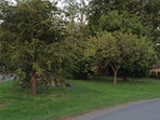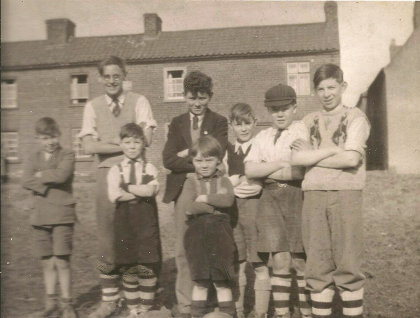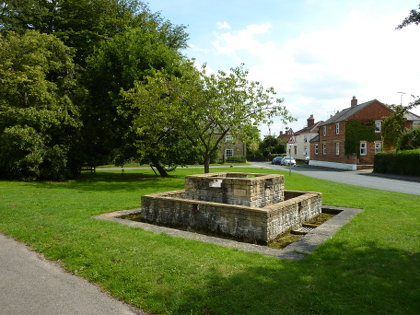Dyke Village Green
The village green is the essence of rural England. Story book images of village greens tend to be an expanse of grass in the centre of the village complete with oak tree, seat and village stocks where the bad guys got their just rewards. Dyke village green boasts the expanse of grass and even the fine mature trees but no stocks. Perhaps no bad guys in Dyke!
Why do Village Greens exist?
 Traditionally the village green was a piece of common grassland in or near the centre of a settlement area.
Traditionally the village green was a piece of common grassland in or near the centre of a settlement area.
.
Traditionally the village green was a piece of common grassland in or near the centre of a settlement area..
It was “common” in that anybody in the settlement could graze their animals there and many of these rights still exist today.
Once a green is registered, and Dyke green is registered, there are severe restrictions placed upon its use. For example, it is a criminal offence to undertake any act which interrupts the use or enjoyment of a green as a place for exercise and recreation or to cause damage to that green. It is also an offence to drive over the green without lawful authority. In times gone bye the village green was an important open-air meeting place for people to gather and exchange gossip and news, it was the “news room” of the village. Villagers would gather together at holiday times or for festivals and the green was an ideal place to meet being central in the village. A typical event for such a gathering was May Day when a ribboned pole enjoy celebrations such as May Day. The first of May may be seen as when warmer weather begins and flowers and trees start to blossom and the cold, dark winter days draw to a close. It would have been particularly significant to a community that depended upon growing crops and raising animals which the people of Dyke certainly did.
Children from Dyke dancing around the Maypole on the village green. 1950.
The origins of common land as we know it lies in the communal farming arrangements of the feudal system. Before the easy availability of land drainage, there were always areas of farmland that were less productive and difficult to improve. The feudal system of the middle ages gave rise to a communal farming system consisting mainly of arable in strip fields and associated common or wasteland. Animals were grazed over the arable once the crop was harvested and the common land was accessible to tenants of the lord of the manor to provide further grazing. These arrangements were regulated by manorial courts. The first English Statute referred to Commons and was passed in 1235. There is evidence that unfenced or “open field” farming was practiced in England during the Roman occupation of the country. The feudal system came to maturity between 850 and 1150 and the comprehensive survey in the Domesday Book of 1086 provides the best documentary evidence of its workings. There had always been old enclosures near settlements (“tofts” or “crofts”) although the majority of a settlements agriculural land would have been subject to communal farming. Crops were rotated with one of the two or three fields left fallow each year to recover its fertility. The origins of the village green lies in customary rights. They were open spaces in villages for communal activities. Though technically originally a trespass, these rights became customary and enforceable through the courts. Many greens would have been subject to rights of common, particularly of pasture. Today the village green is a kept area to be used and enjoyed by all in a village many for recreational purposes as is the case in Dyke.
Dyke Rangers playing football on the green 1950.
Trees on the Green
The ladies of Dyke WI have a reputation for having “good ideas” and the enthusiasm to turn them into reality.
However, when they came up with the idea of planting four trees in the village green to commemorate the WI Golden Jubilee year they found themselves with a slight problem. The problem was simply defined, they could not obtain the necessary permission! What originally was considered as a straight forward project soon became a drama.
In November 1964 Dyke WI wrote to the Urban Council provisionally asking for their permission to plant trees in the village green. The green was, at that time, covered in weeds and not well kept. In June 1965 the Council agreed to the planting of the trees but then another unforseen problem arose. The waters of an underground spring had had risen to the surface and covered the green with several inches of water flooding the area. In December 1965 Dyke WI wrote to the Water Board Engineer stating it was concerned that the green was two-thirds swamped with water. This meant that the proposed planting of trees in the green could not proceed until the green had become water free and dried out.
Dyke Village Green with trees planted by WI in 1966.
As there was no response by September 1966 Dyke requested the county secretary of the WI for action. The Board Engineer wrote to the then chairman of the UDC, Councilor Day, stating that the history of the bore when he declares the that the bore which had been the original water supply to the village had “run wild”. His words, not mine! he commented that daily readings were being monitored and when conditions became favourable they would seal the supply. Eventually the spring was sealed and the green dried sufficient for the trees to be planted in the spring of 1968. The UDC agreed that the WI should purchase the trees and the council would prepare the site and carry out the planting work. The trees are still growing on the green to be enjoyed by all.
The village green showing trees planted by Dyke WI in 1966.
The bore has played another role in the history of the green, a source of water for a decorative well to mark the Millennium. Up until 1953 the inhabitants of Dyke got their water from standpipes located at various places down the Main Road. In 1953 mains water was distributed to Dyke and there was no longer a need for the bore as a water supply. It had already shown that the water running underground could rise to the surface with devastating results so it was decided to tap it and make use of the supply in a water feature. With David Stubbs as Project Engineer seven tons of concrete were poured in to contain the bore and route it into a tank. A stainless steel holding tank surrounded with masonry is fed with a four inch pipe from the bore passing water to an outlet that drains into Car Dyke.
The village green showing the Millenium Well.
In researching this page reference was made to the following:
Scarpbook put together by Mrs E.Needham and celebrating the life and events seen in Dyke.
The web site for the Association of Commons Registration Authorities: Commons and Greens.
A Portrait of Bourne by Rex Needle.
More About:
Dyke WI
The Windmill in Dyke
Dyke Baptist Chapel
Dyke Village Green
Dyke Village Hall
Dyke Engine House
The Railway in Dyke
The Wishing Well Inn
The Car Dyke
Dyke Village Life
Contact Dyke Village Hall
Main Road, Dyke, Bourne, PE10 0AF
Email: contact@dykevillagehall.org.uk





